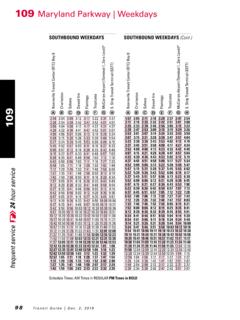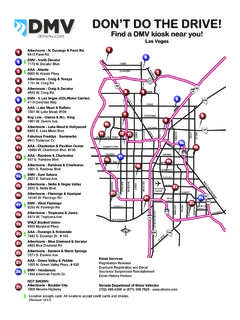Transcription of The Evolution of 802.11 Wireless Security - Kevin Benton
1 The Evolution Wireless SecurityINF 795 - Kevin BentonApril 18th, 2010 Kevin BentonUNLV Informatics-Spring this Wireless Gfeller and U. Spectrum and ISM of the for Network Access Transmission for of the Initial System System Authentication Key Equivalence , Weinmann, and Psyhkin Shared Key Caffe Latte for Configuration and 4-way the Pairwise Transient the Group Temporal Integrity BentonUNLV Informatics-Spring 20102 MPDU Mixing the with Encryption of and Decryption for Protected Protected for BentonUNLV Informatics-Spring 20103 IntroductionThis paper covers a brief history of the Wireless protocols that led up to the creation of networks that drive the consumer and corporate Wireless data networks today.
2 Itthen briefly details how the different common types of networks the basic network functionality, it covers the details of each type of privacy algorithmand authentication procedure offered by the standard along with known following diagram is provided as a reference to illustrate the timeline of the protocolsand vulnerabilities covered in this paper:" Wireless Security Timeline"- Kevin BentonAbout this DocumentThis document is broken into major sections which are designated by roman numerals in thetable of contents. All of the references are contained in the references section of the majorsection that they pertain BentonUNLV Informatics-Spring Wireless NetworksUp until 1985, Wireless data networks didn't have widespread popularity due to licensingrestrictions.
3 The ISM bands that all of the unlicensed radios use today were not opened foruse to the public until 1985. In order to run a Wireless network before then, a license had tobe obtained from the FCC and hardware had to be built to operate on the leased the ISM band was opened for spread-spectrum technology, many companies beganracing to create Wireless hardware compatible with existing data networks. Each technologywas vendor specific so all of the hardware had to be manufactured by the same vendor tofunction correctly. It quickly became clear that a standard would be needed if any of theproducts were going to operate between ProtocolWireless stations operating on the same frequency have to overcome the challenge ofsharing a medium. In 1970, the University of Hawaii developed the first random accessmethod that allowed devices to share a communications medium.
4 [ ] There were twoversions of the protocol: Pure ALOHA, and Slotted ALOHA. Slotted ALOHA was released tofix major inefficiencies in Pure ALOHA protocol eventually evolved into CSMA/CD(Carrier Sense Multiple Access withCollision Detection) and CSMA/CA(Carrier Sense Multiple Access with Collision Avoidance).Both of these protocols are currently used in both wired(CSMA/CD) and Wireless (CSMA/CA)networks. [ ]Pure ALOHAPure ALOHA was the first random access multiple-access protocol for data networks. Inrandom access protocols, all of the stations have equal priority and there is no centralmethod of of the important functions of a random access protocol is to determine how to handlecollisions. Since there isn't a central point of control, multiple stations may transmit at thesame time, resulting in an incomprehensible message for the ALOHA handles collisions by using acknowledgements from the receiving station.
5 If atransmitting station doesn't receive an acknowledgement from the receiving station within atimeout window, the message is considered lost. The sender then waits a time-out periodplus a small random amount of time before retrying the transmission. The random time isrequired to help avoid two stations from transmitting at the same time again.[ ]Finally, if the sender fails to receive an acknowledgement after several transmissionattempts, the frame is considered lost. This prevents the channel from becoming overlycongested by constant retransmissions to a station that may not even be BentonUNLV Informatics-Spring 20105 Slotted ALOHAThe ability for any station to transmit whenever it has data makes pure ALOHA veryvulnerable to collisions.
6 Accordingly, the maximum successful packet rate is 18% of thetotal transmissions. [ ]In order to improve the efficiency of pure ALOHA, slotted ALOHA implements transmissionwindows that the stations are restricted to. By setting windows when each station cantransmit, it greatly reduces the vulnerability a frame has to a collision. The only time acollision can occur is when multiple stations choose the same time slot. The followingdiagrams illustrate the difference between the two protocols."Pure ALOHA and Slotted ALOHA"- Kevin BentonWith the new timing restrictions on transmissions, slotted ALOHA has a successfultransmission rate of about 38%. [ ] While this success rate is relatively low, ALOHA pioneered the field of research in sharing a physical medium between multiple nodes.
7 TheCSMA/CD(used in ethernet) and CSMA/CA(used in ) access protocols were derivedfrom ALOHA.[ ] Gfeller and U. BapstFritzt Gfeller and Urs Bapst published a paper in 1979 outlining a protocol for wirelesscommunication between devices in the same room using infrared diffusion.[ ]The primary purpose of the protocol was to allow several terminals in a room tocommunicate with a single host computer. The host/mainframe could be located in adifferent location; however, it would be need to be wired to a transmitter in the same roomas the terminals that it needed to communicate limitations of the protocol are primarily do to its use of infrared radiation forcommunication. Infrared is very near visible light and carries many of the same two limiting factors are its emission by heat sources such as the sun and its inability topass through solid line of sight wasn't required for the protocol to function correctly.
8 It relied on thediffusion of the infrared sent out by the transmitter. The same effect can be observed withKevin BentonUNLV Informatics-Spring 20106light from a light bulb. Even if a person can't see the light bulb itself, he/she can see thelight from the bulb on most of the objects in a protocol had a theoretical maximum of 260 megabits per second; however, due tobackground infrared interference from daylight limited the rates to less than 1 megabit persecond. The experimental links they tested their protocol with produced rates of 125 kilobitsper second when using pulse code modulation and 64 kilobits per second using protocol was an important step towards Wireless networks today because it did notrequire a license to operate. The ISM band used by networks today had not yet beenopened up by the FCC so there were no other options for unlicensed Wireless Spectrum and ISM BandsIn 1980, Walter Scales published the paper "Potential Use of Spread Spectrum Techniquesin Non-Government Applications".
9 [ ] As the name suggests, spread spectrum techniqueswere not being used for anything other than military and aerospace spectrum works by taking a transmission and spreading it out over a wide range offrequencies. This technique has the following advantages over transmitting on onefrequency: Security - Without knowing the order that the signal is divided into the spectrum,it's very difficult to listen to the transmission. Resistance to Interference- Because the signal is divided across a large bandwidth,interference on one frequency translates into interference on a very small part ofthe total transmission. Channel Sharing - By using different spreading patterns, users can share the samespectrum range with limited paper provided a compelling argument for the FCC to open up bands of the spectrum tothe public to be used with spread spectrum technologies.
10 While the Security aspect was nota major push, the advantage of many users being able to share a single range of bandwidthinterested the 1981, the FCC issued a Notice of Inquiry to conduct research in the general civil use ofspread spectrum technologies. This temporarily granted the Amateur Radio Research andDevelopment Corporation the ability to use spread spectrum technologies.[ ]In 1984, the FCC release a Notice of Proposed Rulemaking that proposed the authorizationof the use of spread spectrum technologies under conditions that didn't interfere with otherusers of the same spectrum.[ ]Finally, in 1985 the FCC authorized the use of spread spectrum technologies in the"Industrial, Scientific, and Medical"(ISM) band. The ISM band includes the followingfrequencies: 902-928 MHz, MHz, and 5725-5850 MHz.
![Forms of Business Ownership[1] - Nevada Small Business ...](/cache/preview/f/2/d/5/2/0/f/a/thumb-f2d520fa3db64de8bc2e7dcba03e2b5b.jpg)






